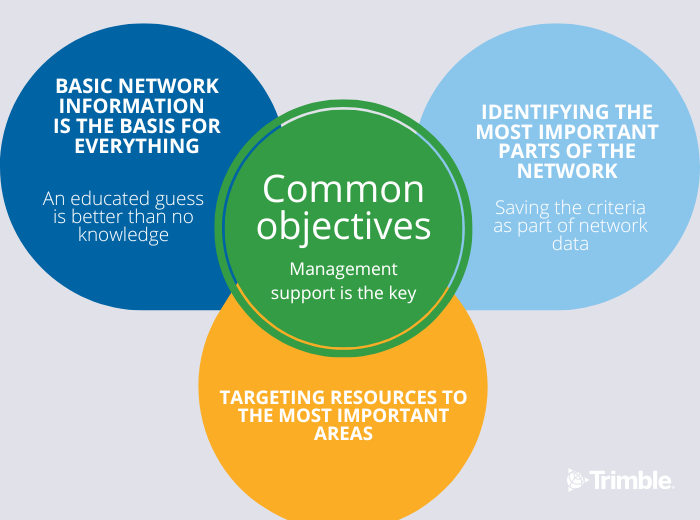Over the past few years, a water utility Hämeenlinnan Seudun Vesi Oy (also known as HS-Vesi) in Finland has developed its asset management process using the Trimble NIS network information system. Development work has paid off.
HS-Vesi is a municipality-owned water utility, established in Finland in 2001. It provides its customers around-the-clock service. The utility's mission is to ensure the supply and distribution of good quality water and the efficient collection and treatment of waste water in its area of operation. The utility serves around 80,000 people and has more than 2,600 km of network.
Over the past few years, HS-Vesi has been determined to improve its asset management process with the help of the Trimble NIS network information system. The benefits, both in day-to-day work and in financial terms, are clearly visible. At the same time, the operating model developed by HS-Vesi and Trimble also helps the water utility to fulfill its obligation to monitor the condition of its water supply network, as required by the Finnish Water Management Act. But how did they get there, and where did it all really begin?
Change is driven by clear goal and the will to succeed
In 2019, HS-Vesi was faced with a pressing need to develop its asset management process. Due to overflows in the wastewater network, the utility set the development of asset management as a strategic goal. In the waste water network in particular, the objective was to improve maintenance as part of the overall system. At the same time, the Water Utility Asset Management Handbook (Water Utility Association, VVY, 2019) was being prepared and HS-Vesi was involved in the work. The asset management framework developed by HS-Vesi can still be found as an example in the handbook.
"At the company level, we started with a day-to-day approach of what processes and functions needed to be put in place. We started at the grass-roots level – first with field work – and had strong management support throughout the project," says Jarno Laine, Planning Manager at HS-Vesi.
When planning the development steps, it was quickly realized that in order to achieve the objectives, concrete information on the network and its condition was needed. HS-Vesi did not have to start from scratch. The systematic documentation of the network in the Trimble NIS network information system over a long period of time provided a good basis for further development. With the basic attributes (diameter, material and year of installation for pipes), it is already possible to get a good grasp of how the long term infrastructure deficit is formed and how it can be managed.
HS-Vesi had already implemented Trimble’s Utility To Go mobile application to support field work in 2015, so it was familiar to users at this stage. Regular valve inspections in the field had also started around the same time.
"The fact that we had started using Utility To Go in the field a few years earlier made it easier for us to develop our asset management process. We were able to take the initial data from Trimble NIS. The network model contained information on which objects we already had data on, which parts of the network were maintained and what condition our network was in," says Jarno Laine.

The journey to a successful outcome
The utility's clear purpose and strong will drove the change in operating model and culture. There were several steps along the way: setting the utility’s objectives, defining the criteria for prioritizing the network, identifying the most important parts of the network, and improving the quality of the existing network data.
For success, it was essential that people at different levels of the organization (company management, heads of units, foremen) were on the same page in terms of objectives. Internal discussions on key processes and objectives, and the documentation of these, made it easier to implement the change and follow the right track during the change.
In addition to setting goals, maintenance practices were actively worked on with the field crews and management.
"Supporting the staff who use the systems is key for us – what, for example, the foremen and technicians need and suggest. They play a crucial role in this process by carrying out inspections that provide information on the actual condition of the network," Laine says.
Trimble's role in the project was to find ways to make the network information system meet the utility's objectives and the users' needs. Feedback from the utility’s foremen and other users was a priority when changes supporting the new operating model were made to the system.
Along with being used in the maintenance process, Trimble NIS was also introduced in investment planning. A project planning framework was defined in Trimble NIS to identify project scope, to design and present a preliminary solution, and to calculate a preliminary cost estimate for the project.
The projects identified in the planning process are prioritized based on a score that is calculated using defined criteria. HS-Vesi used external consultant to help their own resources in defining the criteria and formula. As information becomes available, a regularly updated list of projects will provide direction for the renovation sequencing and overall project planning.
The result was a functional and dynamic approach to asset management, with a division into three parts. "In simple terms, this means that first we identify the parts of the network, the condition of which we should be aware of. Secondly, the network information system is harnessed to use the available data to identify the objects that should be repaired, and also, thirdly, the parts of the network that should be renovated," summarizes Laine.
An example of knowledge-based management: monitoring the degree of condition awareness by maintenance area
Today, asset management is part of the day-to-day activities at different levels of an organization. Documentation and data collection is done in the field in the network information system. The use of accumulating data as part of the network information system enables reporting and knowledge-based decision-making. The network information system is built to support the operating model, which makes it easier for the water utility staff to take into account the strategic objectives of the utility, for example in maintenance planning. In this way, the objectives also guide the day-to-day work of the staff.
"If you were to ask a water network technician what kind of asset management they do today, they would probably answer that they do the normal technician's work. But in fact, they would be doing the most important job – and that’s checking the condition of the network and doing maintenance.”
Through this operating model, knowledge-based management has become part of everyday life. The new operating model emphasizes long-term planning, with decisions based on clear numbers. This is at the heart of the utility's culture at all levels. Renovations are correctly targeted to where they are needed, based on the condition of the network – not too late or early.

Compared to a conventional renovation programme for water networks, HS-Vesi's approach is dynamic. The renovation programme is updated when the condition of the network changes and more information becomes available. Changes can also be made on the basis of feedback received.
"A renovation programme that changes all the time is more usable and easier to use in everyday life than a stand-by programme that defines exactly what to do and when," Laine says.
"By taking the critical items from the list first, we can find the priorities for maintenance and renovation. Pipes are not renovated in the traditional way when 60 years have passed, but they have a service life of between 40 and 70 years (depending on condition). Our logic is that by knowing the condition of the network, we can at least reach the planned technical lifetime," Jarno Laine continues.
The savings in euros are particularly visible in long-term investment planning. The process can be started well in advance, reducing the risks of late tendering or going over budget.
"We now know our goals well in advance. With a timeframe of three to five years, we can coordinate all the inspections for renovation and start the entire process earlier. For example, in the fall (2021), we were able to work with an engineering consultant to plan projects for 2023–2025. This would have been very difficult, if not impossible, with the previous operating model," says Laine. Tendering done ahead of time can save up to hundreds of thousands of euros.
A similar trend can be seen not only in investment planning, but also in maintenance. At the corporate level, the goal was to have 50% of maintenance actions planned in advance by 2022. The operating model enables the goal to be achieved. It creates the conditions for a shift in focus towards more proactive maintenance in the future.
"We strive to plan the coming year's maintenance actions in advance with manhole/valve precision. Work can be assigned digitally directly to the field crews with Utility To Go, which makes everyday life easier. Of course, there has to be room for maneuver, and you can never plan everything with 100% accuracy. There will always be leaks and blockages – things you can't know in advance."
Other benefits
The asset management process developed by HS-Vesi has also produced results in the cooperation between the water utility and municipalities. Benefits can be seen, for example, in the coordination and scheduling of investment projects and in the management of the stormwater network.
"Our goal was that during 2021, we would propose a renovation programme until 2030 for all our three municipalities. There are now almost 800 investment projects on the agenda on the timeline up to the 2040. All projects have a preliminary cost estimate and are ranked by known condition. We are now in a position to prioritize our inspection and planning resources for the coming years. Significant savings can be made from the planning reserve, for example through tendering done ahead of time."
The municipalities that are owners of the utility, are responsible for the overall management of stormwater in areas subject to urban planning. The municipalities follow the utility’s operating model and use the same network information systems, which streamlines cooperation between the water utility and the municipalities.
It is worthwhile for the water utility to take the initiative on stormwater issues, even if the overall responsibility for stormwater does not, in principle, fall to the water utility.
"To a large extent, stormwater management is a joint effort, and a functioning stormwater system will result in reduced sewer leakage, for example."
Looking to the future
The more you get, the more you want. The framework for the operating model is in place and new goals are already in sight. The next step is to develop reporting to support the policy, which will also contribute to strengthening knowledge-based management. HS-Vesi also has concrete tips for any water utility just starting its asset management work.
"It's worth getting started today! You don't need a massive project to get started; a water utility can proceed in small chunks. First define what you want to achieve, and identify and focus on the most important parts in the network, such as the water mains. Day by day and week by week, the benefits increase. Within a few years, knowledge-based management will definitely increase."
"A water utility can start to identify the most important issues in network maintenance. For example, the network information system can be used to define main water pipes and main sewers. Is the network hierarchy in place? What are the most important parts of the network? By separating the main pipes and other pipes by type, you can allocate the available resources in the best possible way. You can then proceed to review, for example, the valves in the main water pipes and target them with prioritized actions.
"It is worth involving the software vendor early on in the discussion, but before that, the utility itself needs to define its own vision. Without it, the desired culture change will not happen either," Laine says.
The development process of a new operating model may change along the way, and clear objectives help keep you on the right track. It's best not to make overly detailed plans. It’s important to have a plan, but you should also be prepared to adapt and refine it as you go along.
"A good starting point is to move from the big picture to the smaller one, making sure there is a clear vision of what you want to achieve. Once vision is in place, help is at hand," Jarno Laine concludes.


